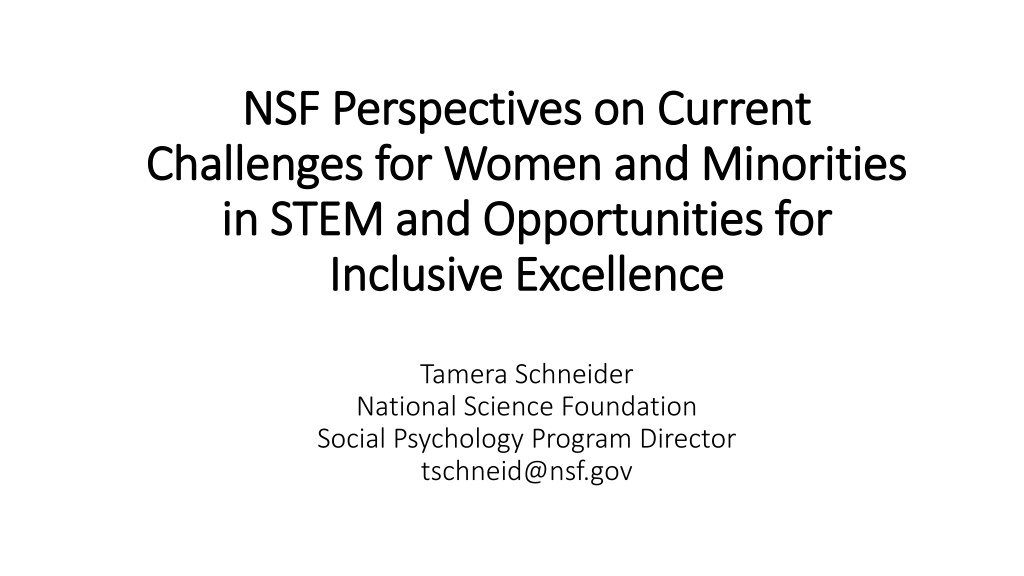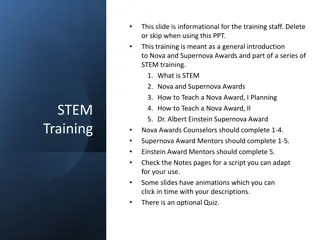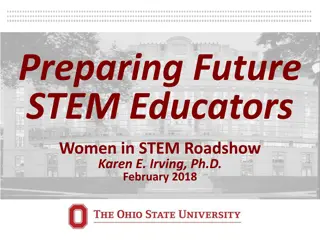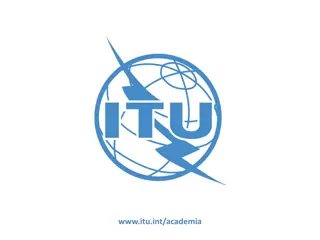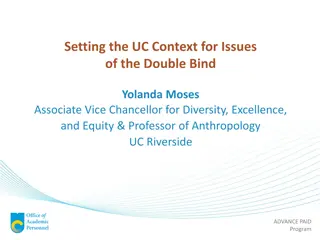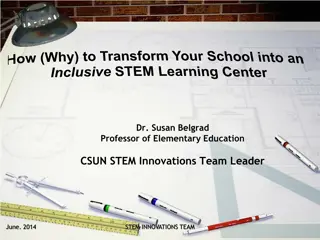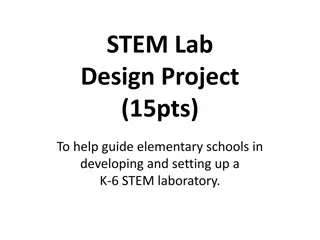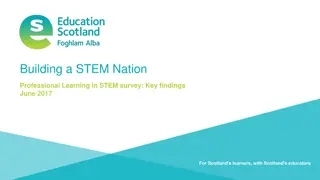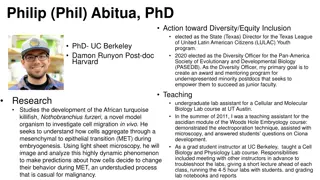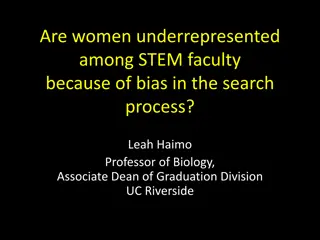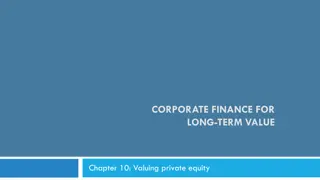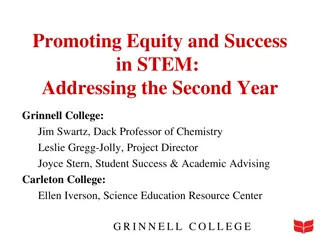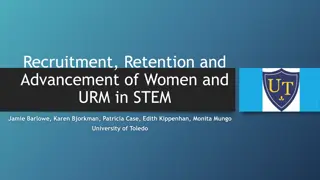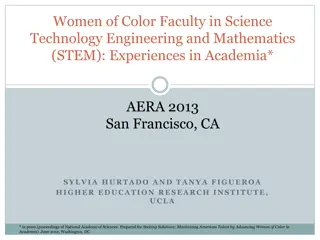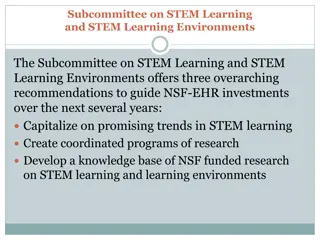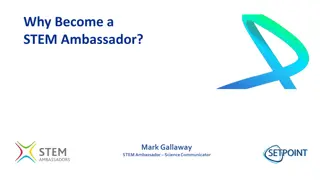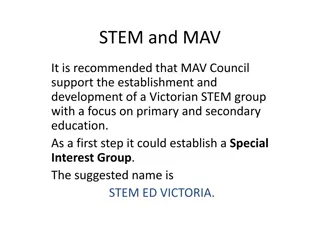Enhancing Gender Equity in STEM Academia: Challenges and Opportunities
The ADVANCE model aims to promote gender equity in academic STEM careers through systemic approaches. Addressing issues like culture, recruitment, and work-life balance can lead to long-term change. Equity issues, including pay gaps, persist despite improved representation. Various influencers in STEM academia, beyond higher education institutions, also play a role in shaping culture and climate.
Download Presentation

Please find below an Image/Link to download the presentation.
The content on the website is provided AS IS for your information and personal use only. It may not be sold, licensed, or shared on other websites without obtaining consent from the author. Download presentation by click this link. If you encounter any issues during the download, it is possible that the publisher has removed the file from their server.
E N D
Presentation Transcript
NSF Perspectives on Current NSF Perspectives on Current Challenges for Women and Minorities Challenges for Women and Minorities in STEM and Opportunities for in STEM and Opportunities for Inclusive Excellence Inclusive Excellence Tamera Schneider National Science Foundation Social Psychology Program Director tschneid@nsf.gov
The ADVANCE Model: Toward a Robust and The ADVANCE Model: Toward a Robust and Inclusive STEM Workforce Inclusive STEM Workforce develop systemic approaches to increase the representation and advancement of women in academic STEM careers develop innovative, sustainable pathways toward gender equity for men and women in the STEM academic workforce contribute to the evidence base on gender equity and its intersection with other identities in STEM academic careers
Systemic & Organizational Change Systemic & Organizational Change ADVANCE addresses the systems and organizations that drive access and success Issues that impact equity: Culture and climate Recruitment, retention, tenure, and promotion policies and practices Work-life balance and career flexibility policies, programs, and usage Salaries, start-up packages, access to resources Institutional service allocations and requirements (committees, mentoring) Accountability of STEM leadership, commitment to diversity Systemic and organizational change can evoke long-term change
Equity (fairness, impartiality) Equity (fairness, impartiality) Issues may exist even if proportional representation is achieved Pay gaps are one example of a gender equity issue in academics that persists, even with full participation of women AAUP Faculty salary survey data U.S. doctoral institutions 2014-2015
Many Influencers of Culture & Climate in STEM IHEs are not the only organizations that impact gender equity in STEM academics Professional societies Publishers and editorial boards Policy and research entities State systems of higher education and legislation/funding Industry Advisory boards Funding organizations and federal agencies HRM Title IX Social Science Research Faculty & Leaders
Reach of ADVANCE Program and Strategies
NSF ADVANCE NSF ADVANCE Broad Reach Broad Reach 65 Institutional Transformation awards (~2% of all non-profit U.S. IHEs) TOTAL ADVANCE PROGRAM BUDGET (MILLIONS) 28% of very high research IHEs 25 20 Adaptation and Partnership awards to spread promising practices 15 99 additional non-profit U.S. IHEs 10 14 non-profit organizations (such as STEM professional societies) 5 FY 10 FY02 FY03 FY04 FY05 FY06 FY07 FY08 FY09 FY11 FY12 FY13 FY14 FY15 FY16 FY17
Organizational Strategies that Work Improvement of Institutional Structures Institutional data collection systems; Creating expectations for public reporting of data; Establish processes for using data in decision making; Review and revision of policies, practices, and processes (hiring, tenure, promotion and others) for transparency, clarity, and consistency Equitable Career Support for Individuals Formal mentoring programs; Faculty leadership development; Research network development; Policies to support faculty during life events and critical junctures; Checklists for start up packages for candidates Empowerment of Individuals and Leaders Training and awareness building of gender equity issues (implicit bias, micro-aggressions, stereotype threat); Creating tools and resources for faculty and leadership decision making; Creating accountability measures for decision makers; combating isolation and creating networks for women in STEM Work Life Support Policies Dual career offices and policies; flexible academic career policies; dependent care policies; other work-life balance programs; training for leadership on the implementation of these policies and programs See also Strategies for Effecting Gender Equity and Institutional Change http://www.colorado.edu/eer/research/strategic.html
ADVANCE Institutional Transformation Montana State University Intervention with search committee chairs had impact on hiring of women compared to control search committees (total searches=23): 6.3 times more likely to make an offer to women Women were 5.8 times more likely to accept an offer if made The intervention was provided by a faculty peer: 1) Tip sheet and search toolkit overview Jessi L. Smith et al. BioScience 2015;65:1084-1087 2) 30 min overview of implicit biases 3) Discussion of work-life integration and suggestion to have candidates meet with a family advocate for 15 mins
ADVANCE Disseminating Lessons Learned The Association for Women in Science (2010) worked with 18 scientific societies to provide implicit bias training for awards committees and review award guidelines. The societies that made changes to the language in their call for nominations and selection process have had increases in the percentage of awards made to women in those disciplines Data from 7 societies working with AWIS for 3 years (www.AWIS.org)
ADVANCE Tools University of Washington LEAD-it-Yourself! (LiY!) toolkit (PAID 1310305) Online open source toolkit that provides planning and instructional materials for leadership training workshops (train the trainers). Builds on ADVANCE IT 0123552 and PAID 0619159 University of Wisconsin-Madison Bias Literacy workshop Bias literacy workshop to educate STEMM (science, technology, engineering, mathematics, and medicine) faculty about implicit gender bias in academia (NIH WISELI, 2010). The workshop in a box contains everything needed for facilitators to implement a 2.5 hour workshop. Builds on ADVANCE IT 0123666
International Interest in ADVANCE and Modeling ADVANCE International Activities Global Research Council - gender equity in STEM research was one of the agenda items for research funding agencies at the 2016 meeting ADVANCE attended the Americas regional in preparation ADVANCE invited to present at International Gender Summits NSF was an observer on the European Union funded GENDER-NET 2015-2016 ADVANCE regularly asked to meet with State Department delegations of women in STEM Adaption of the ADVANCE model The EU Commission created a grant program to support institutional transformation in the EU in 2010
ADVANCE IT Institutions STEM Female Faculty ADVANCE IT Institutions STEM Female Faculty Total STEM Female Faculty Change in Representation 50% p < 0.001 Final % in total female faculty representation 40% 30% 20% 10% ** p = 0.003 p < 0.001 0% 0% 10% 20% 30% 40% 50% Initial % in total female faculty representation ADVANCE IT Institutions Cohorts 1-4 (n=41) * p = 0.01
Indicators of Organizational Transformation Indicators of Organizational Transformation Changes in Policy Areas Addressed by ADVANCE IT Institutions Institutions that Indicated Positive Change (%) 84 84 58 58 58 Institutions that Addressed Policy Area (%) 90 95 79 90 79 Policy Area Recruitment Hiring Research Support Tenure Criteria Standards for Promotion to Full Professor Work Life Balance 79 68
Indicators of Organizational Transformation Indicators of Organizational Transformation Area of Accomplishment Accomplishment 49% increase in women STEM faculty Description The percentage of women among STEM faculty increased by 49% between 2001 and 2008 (from 16% to 24% of faculty). Compared to 24% increase over same time period in comparison group (from 22% to 27% of faculty). STEM Women s Representation STEM Hiring 40% increase in new women STEM hires The percentage of women among new STEM hires increased by 40% in the first six years of the grant (from 25% to 35% of new hires). Women in Leadership 64% increase in STEM women in leadership The percentage of STEM women serving in leadership positions increased by 64% between 2001 and 2008 (from 10% to 16% of leadership). .
Indicators of Organizational Transformation Indicators of Organizational Transformation Area of Accomplishment Publications Accomplishment 146 peer reviewed publications Description The first cohorts of ADVANCE institutions are responsible for producing 146 peer reviewed publications on STEM institutional transformation. gender equity and Presentations 581 professional presentations Over 500 professional presentations were delivered on gender equity and institutional transformation at national/international scientific meetings. Research Support 90% allocated research facilities and resources 90% of the first cohort of ADVANCE institutions (up from 26%), allocated facilities and resources to equity/diversity related functions after the life of the grant. Strategic Planning 79% inclusion of gender in strategic plans 79% of the first ADVANCE cohorts (up from 22%), incorporated equity/diversity objectives into their strategic plans .
Indicators of Organizational Transformation Culture and Climate Metrics 80 Deteriorated Somewhat Little or No Change 70 70 Improved Somewhat 64 Improved Considerable 60 Percent of Institutions 50 50 47 44 44 40 33 31 31 30 30 30 25 24 20 20 20 15 Data collected by the WESTAT program evaluation of ADVANCE 2012 when available from the first ADVANCE IT awardee institutions (so the n is <19). 10 6 6 6 0 0 0 0 0 0 Overall Satisfaction (n=16) Overall Collegiality (n=17) Women Satisfaction w/Jobs and Career (n=16) Men Women Ties w/ Other STEM Faculty in the Institution (n=17) Women Ties w/ Other STEM Faculty Outside the Institution (n=15) Satisfaction w/Jobs and Career (n=16)
Areas for further research and understanding
Areas for Further Research and Understanding Areas for Further Research and Understanding Strategies focused on the intersection of gender, race and ethnicity, disability, LGBTQ, foreign born, foreign trained, etc. have not been developed. What does the transition to relying on non-tenure track faculty for teaching mean for gender equity in academics? How can we measure and evaluate systemic change? What are the metrics to measure organizational change in relation to gender equity if it is not just counting individual women in STEM academics? How do State policies and economic issues impact systemic change efforts?
Persistent Issues Impacting Equity in STEM Academics Lack of understanding of intersectionality Not all women have the same experiences in the same institution Gender may not be the most influential in any given situation Interventions for women may not be effective for women of color etc. Lack of awareness of Title IX protections in STEM Pregnancy discrimination - STEM faculty and leaders are giving bad advice because they do not know the rules & programs Joan Williams and Mary Ann Mason http://www.toolsforchangeinstem.org/ On-going explicit bias and sexual harassment Inadequate systems to discourage and stop it or to deal with it after it happens The power structure of senior faculty, advisors, and mentors in STEM academics inhibits complaints
ADVANCE Grant Types ADVANCE Grant Types NSF 16-594 Institutional Transformation (IT) Adaptation Partnership Develop, implement, and study innovative organizational change strategies to foster gender equity Adapt proven organizational gender equity strategies Scale-up proven systemic gender equity strategies for national or regional impact Up to $1M over three years Up to $3M over five years Up to $1M over 3-5 years Single IHE that has not had IT before (all STEM) Single non-profit org. (one or more disciplines) Single IHE that has not had IT before (all STEM) or Two or more partner orgs. One or more disciplines Preliminary proposal April 12, 2017* (required) Proposal (if invited after preliminary) Jan. 17, 2018* LOI Dec. 14, 2016* (required) Proposal Jan. 11, 2017* LOI Aug. 9, 2017* (required) Proposal Sept. 13, 2017* *These deadlines will recur every other year until the solicitation is replaced.
Best Practices across the U.S. Federal Context Analyses of Mandated Workforce Data Sets Federal Viewpoint Survey, Federal Equal Opportunity Recruitment Plan, EEO status report, Complaints Workplace climate assessments, reach hiring goals, compared over time for opportunities Implicit Bias Training Most include mandatory training for supervisors and managers Online, informational briefings, workshops, in-class training Conflict Resolution Fair, effective, and accessible (Anti-Harassment Program (AHP) at NASA Lowers # of formal complaints; disputes resolved at an early stage Work Flexibility Leadership proactivity matters; collect input about options, conditions for their use, potential impacts on performance assessments Reducing the Impact of Bias in the STEM Workforce, Interagency Policy Group, Nov., 2016
Promising Practices across the U.S. Federal Context Diversity Change Agents Understand nature of bias, provide training to others Diversity Toolkits Themes: Informing employees of rights and responsibilities, leadership commitment, attracting top talent, cultivating excellence, teamwork and innovation, serving the American people, advancing STEM Technical Qualifications Boards Establish criteria before review and address those criteria then bias is reduced Promotions and research positions Proposal Review Experiments Recruit diverse faculty as reviewers Virtual panels, reviewer orientation Reducing the Impact of Bias in the STEM Workforce, Interagency Policy Group, Nov., 2016
Thank you tschneid@nsf.gov
